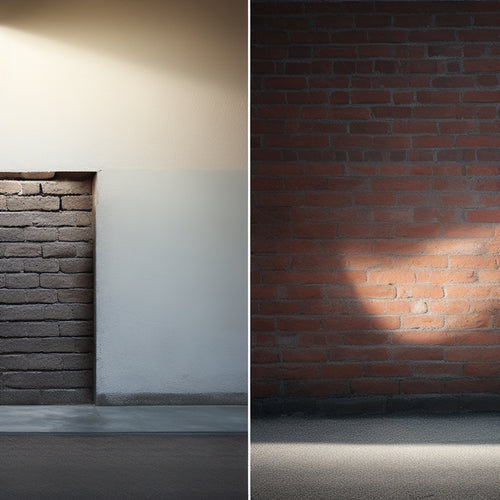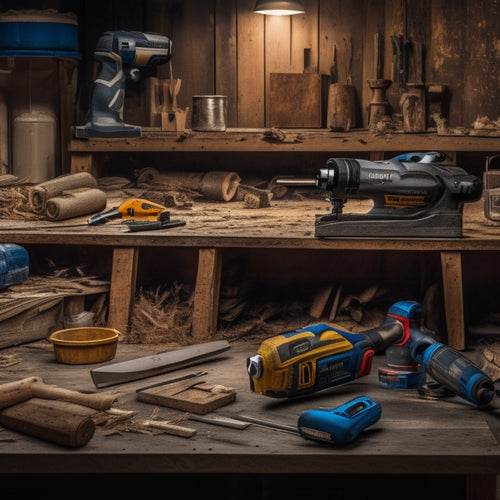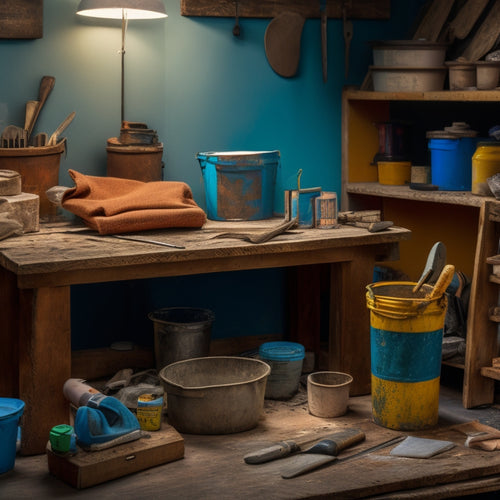
Final Inspection Checklist for Home Renovation
Share
As you near the end of your home renovation, it's crucial to conduct a thorough final inspection to guarantee every detail meets your expectations. Start by verifying exterior finishes, inspecting gutters and downspouts, and evaluating landscaping. Move inside to review interior walls and ceilings, checking for defects, scratches, or uneven surfaces. Examine flooring, baseboards, doors, and windows, checking for secure installation and proper functioning. Don't forget to inspect cabinets, countertops, plumbing fixtures, and electrical outlets, as well as finalize block wall repairs. By following this extensive checklist, you'll be well on your way to identifying and addressing any issues before completing your renovation - and the next step is just a detail away.
Key Takeaways
• Verify exterior finishes, such as siding, trim, and molding, are securely fastened and free of gaps or cracks.
• Inspect interior walls and ceilings for defects, unevenness, and improper installation of fixtures and finishes.
• Check flooring, baseboards, doors, and windows for proper installation, secure fastening, and functionality.
• Ensure plumbing fixtures and appliances are free of leaks, moisture, and water damage, and operate correctly.
• Conduct a thorough review of electrical outlets, lighting, and switches to ensure proper installation, safety, and functionality.
Exterior Finishing Touches Inspection
As you step outside, begin by verifying that all exterior finishes, including siding, trim, and molding, are properly installed and securely fastened.
Check for any gaps or cracks in the siding materials, confirming they're properly sealed to prevent water intrusion. Inspect the trim and molding for any signs of damage, rot, or warping, and validate they're securely attached to the exterior walls.
Next, evaluate the landscaping details, such as the grading and drainage around the foundation. Ascertain the soil slopes away from the house to prevent water accumulation.
Check the gutters and downspouts for proper installation, securement, and functionality. Verify that all exterior fixtures, including outdoor lighting and electrical outlets, are installed correctly and meet local building codes.
Interior Walls and Ceilings Review
Now that the exterior finishing touches have been verified, you'll shift your attention to the interior, where a thorough examination of the walls and ceilings is necessary to confirm a successful renovation. As you walk through each room, take note of any imperfections or defects that need to be addressed.
Conduct a wall texture assessment to verify the finish meets your expectations. Check for:
-
Uniformity: Verify that the texture is consistent throughout the room, with no visible inconsistencies or unevenness.
-
Defects: Look for any scratches, dents, or holes that need to be repaired or filled.
-
Finish quality: Inspect the finish for any imperfections, such as dust, dirt, or uneven sheen.
In addition to the walls, perform a ceiling fixture evaluation to confirm all components are securely fastened and functioning properly. Check that all light fixtures, ceiling fans, and vents are properly installed and operational.
A meticulous review of the interior walls and ceilings will give you peace of mind, knowing that your renovation has been completed to the highest standards.
Flooring and Baseboards Check
What's the condition of your newly installed flooring, and are the baseboards properly aligned and securely fastened?
As you inspect your flooring, check for any defects, scratches, or unevenness in the surface. Verify that the flooring materials, whether hardwood, tile, or carpet, are correctly installed and meet your expectations. Confirm that the floors are level, and the changes between different flooring materials are smooth.
Next, examine the baseboards, paying attention to their style, material, and installation. Are they the correct baseboard style you specified, and do they match the rest of the house?
Check if they're securely fastened to the walls, and if there are any gaps or cracks between the baseboards and the flooring. Make sure the baseboards are level and plumb, and that they're not damaged or scratched.
Take note of any areas that require touch-ups or repairs. By meticulously inspecting your flooring and baseboards, you'll confirm a flawless finish that meets your renovation goals.
Doors and Windows Examination
Inspecting your doors and windows is essential to confirming proper functionality, as even slight defects can compromise the overall integrity of your home's renovation. You'll want to pay close attention to the details to avoid costly repairs down the line. Here are some key areas to focus on:
- Door frame alignment: Confirm that all doors are properly aligned within their frames, with even spacing and no signs of warping or sagging.
Check that door frames are level and plumb, and that doors open and close smoothly without catching or sticking.
- Window seal integrity: Inspect windows for any signs of seal failure, such as fogging, moisture, or condensation between the panes.
Check that windows operate smoothly, with no sticking or difficulty opening or closing.
- Hardware and accessories: Verify that all door and window hardware, including handles, locks, and hinges, are securely attached and functioning properly.
Check that all accessories, such as window screens and door sweeps, are properly installed and in good condition.
Painting and Trim Work Inspection
As you move on to inspect the painting and trim work, you'll want to examine the walls closely for any imperfections or defects in the paint quality.
Next, you'll verify that the trim installation meets the specifications and is properly aligned.
Wall Paint Quality Check
You're now ready to assess the wall paint quality, verifying that the painting and trim work meet the project's specifications and your expectations.
As you inspect the walls, remember that the paint job is a vital aspect of your home renovation. It's important to guarantee that the paint color selection and paint finish options align with your original vision.
Here are three key things to check:
-
Color Consistency: Verify that the paint color is consistent throughout the room, with no visible differences in shade or tone. Check for any areas where the color may have been compromised, such as around electrical outlets or switches.
-
Finish Quality: Inspect the paint finish, confirming it meets the specified level of sheen or gloss. Check for any imperfections, such as roller marks, drips, or unevenness.
-
Coverage and Adhesion: Check that the paint covers the entire surface, with no bare spots or uneven coverage. Also, verify that the paint adheres well to the wall, with no peeling or flaking.
Trim Installation Verification
With the paint quality checked, turn your attention to the trim installation, verifying that all molding, baseboards, and window and door casings are properly installed and securely fastened.
Perform a thorough trim quality assessment to guarantee that the trim is free from defects, such as cracks, dents, or uneven joints. Check that all trim pieces are correctly aligned and securely attached to the walls and floors.
Inspect the trim style options, confirming they match the agreed-upon design specifications. Verify that the trim profiles, widths, and materials align with the original plan. Pay attention to the trim's finish, making sure it's smooth, even, and free of imperfections.
Check for any signs of warping, splitting, or other damage that may affect the trim's appearance or functionality.
As you inspect the trim installation, keep an eye out for any gaps or inconsistencies in the joints. Ascertain that all joints are properly caulked and sealed to prevent air leaks and moisture intrusion.
Finish and Detailing
Inspect the finished paint and trim work to ascertain a flawless visual appeal, scrutinizing every detail to confirm that the final product meets your expectations and the agreed-upon design specifications.
This is your last chance to verify that the design elements you carefully selected are accurately executed.
Verify that the paint job is smooth, even, and free of imperfections. Check for:
-
Uniform color and finish: Confirm that the paint color matches the agreed-upon shade and that the finish is consistent throughout.
-
Proper trim installation: Verify that the trim is securely fastened, properly aligned, and free of gaps or cracks.
-
Material selection consistency: Confirm that the materials used for trim work, such as wood or MDF, match the specified material selection and are of high quality.
Cabinets and Countertops Review
Verify that all cabinets are properly aligned, securely fastened to walls and floors, and functioning smoothly, with doors and drawers operating correctly and staying shut when closed.
Check for any signs of unevenness or sagging, which can indicate improper installation or structural issues. Ascertain that all cabinet components, including hinges, handles, and drawer glides, are securely attached and functioning as intended.
Next, inspect the countertops, paying close attention to the seams where separate pieces meet. Verify that the seams are tight, even, and free of gaps or cracks.
Check for any signs of unevenness or warping, which can indicate improper installation or material defects. Ascertain that all countertop edges are smooth and even, with no rough or sharp edges that could pose a safety hazard.
Finally, check that all cabinets and countertops are properly secured to the walls and floors to prevent tipping or shifting over time.
Plumbing Fixtures and Appliances
As you inspect the plumbing fixtures and appliances, you'll want to pay close attention to potential leaks and water pressure issues.
You should check every faucet, showerhead, and toilet for signs of moisture or water damage, ensuring that all connections are secure and watertight.
Next, you'll need to perform a water pressure test to guarantee that the system can handle the demands of your newly renovated home.
Leaky Faucet Check
Turn off the water supply to each faucet and run the water to drain the pipes before checking for leaks at the faucet handles, aerators, and drain assemblies. This is an essential step in making certain your newly renovated home is free from pesky leaks and water damage.
When inspecting the faucets, pay close attention to the following areas:
-
Faucet handles: Check for any signs of moisture or water droplets around the base of the handle, indicating a faulty O-ring or gasket. Adjust the handle to guarantee proper alignment and tighten any loose parts.
-
Aerators: Inspect the aerator screens for mineral buildup or debris, which can cause leaks. Clean or replace them as needed to guarantee a smooth water flow.
-
Drain assemblies: Verify that the drain gaskets are properly seated and tightened to prevent water from seeping onto the countertops or floors.
Water Pressure Test
You'll need to subject your plumbing fixtures and appliances to a water pressure test to confirm they can withstand the normal operating pressures. This test is vital to guarantee that your plumbing system can handle the water pressure without leaking or bursting. The test should be conducted according to plumbing standards, which typically require a pressure of 30-50 psi (pounds per square inch) for a minimum of 15 minutes.
During the test, you'll need to inspect all plumbing fixtures and appliances, including faucets, toilets, and water heaters. Look for any signs of leaks, sweating, or other issues.
Check the water meter to confirm there's no water loss during the test. If you notice any problems, you'll need to identify and fix the source before proceeding.
Electrical Outlets and Lighting
During your final inspection, are all electrical outlets properly installed, securely fastened, and positioned at the correct height according to local building codes and regulations?
Verify that outlets are spaced correctly, with no exposed wiring or signs of wear.
Check that lighting fixtures are securely mounted, and their finish matches the design plan.
Ascertain that all light switches operate smoothly, and their covers are securely fastened.
Here are three key things to inspect:
-
Outlet placement: Confirm that outlets are situated at the correct height, typically 12-18 inches above the floor, and spaced no more than 6 feet apart.
-
Lighting fixtures: Verify that lighting fixtures are compatible with the ceiling type (e.g., recessed, surface-mounted, or pendant lights).
-
Grounding and polarity: Ascertain that all outlets are properly grounded, and their polarity is correct to prevent electrical shock.
Final Block Wall Repair Verification
Verify that all block wall repairs have been completed according to the renovation plan, with no signs of cracks, damage, or water seepage. You want to confirm that the repairs have restored the block wall integrity, providing a solid foundation for your home.
Check if the repair materials used are in line with the original plan and specifications. Verify that the repair material selection aligns with the type of block wall you have, whether it's concrete, cinder, or any other type.
Inspect the repaired areas closely to confirm that the joints are properly filled, and the surface is even and smooth. Check for any signs of settlement or shifting, which could indicate underlying issues.
Make sure the repairs are complete, and there are no gaps or openings that could compromise the wall's structural integrity.
Frequently Asked Questions
What Is the Ideal Checklist Format for a Home Renovation Final Inspection?
When creating an ideal checklist, you'll want to organize it into logical categories, such as exterior, interior, and mechanical systems.
Within each category, define specific inspection criteria, including visual checks, performance tests, and material evaluations.
This structured approach guarantees you're thorough and efficient during the final inspection.
Can I Still Make Changes After the Final Inspection Is Complete?
Think of your final inspection like a marathon finish line - you've crossed it, but that doesn't mean you can't make adjustments to your stride.
While it's ideal to wrap up changes before signing off, you can still make post-inspection modifications.
However, be prepared for renovation timeline adjustments and potential additional costs.
You'll need to renegotiate with your contractor and revisit your budget.
It's crucial to weigh the importance of these changes against the impact on your project's schedule and bottom line.
Who Is Responsible for Obtaining Necessary Building Permits?
You're responsible for obtaining necessary building permits, ensuring compliance with local building codes.
It's essential to submit a thorough permit application, as incomplete or inaccurate submissions can lead to delays.
As the homeowner, you're accountable for understanding and meeting the regulatory requirements, so don't assume your contractor will handle it.
Verify that all necessary permits are in place before proceeding with your home renovation project.
How Long Does a Typical Final Home Renovation Inspection Take?
You're likely wondering how long a typical final home renovation inspection takes. The answer depends on several inspection factors, including the project's complexity, size, and number of rooms.
On average, a thorough inspection can last anywhere from 2 to 6 hours, with some taking even longer.
Expect a more extensive inspection for larger, multi-story homes or those with numerous custom features.
What Happens if I Find Defects After Moving Into My Renovated Home?
Did you know that nearly 80% of homeowners discover defects after moving into their newly renovated homes? If you're one of them, don't panic! You're not alone.
Post-move issues can arise, but it's vital to address them promptly. Make sure you document every defect and notify your contractor in writing.
Pursue defect resolution through a clear communication channel, and consider mediation or legal action if necessary.
Conclusion
With your renovation's final flourishes firmly in place, flaunt your flawless finishes, from facades to fixtures.
Confirm that every corner, crevice, and curve has been meticulously managed, meeting your meticulous standards.
Now, stand back and savor the sweet satisfaction of a superbly renovated space, where every detail has been deliberately designed to dazzle.
Related Posts
-

Why Use Concrete Blocks in Home Renovation
You're considering using concrete blocks in your home renovation, and for good reason: they offer a unique combinatio...
-

10 Best Power Tools to Buy for Home Renovation
To tackle your home renovation project efficiently, you'll need the right power tools for the job. A cordless drill f...
-

DIY Plastering Supply Checklist for Home Renovation
To tackle a DIY plastering project for your home renovation, you'll need a solid checklist of supplies. Start with es...


